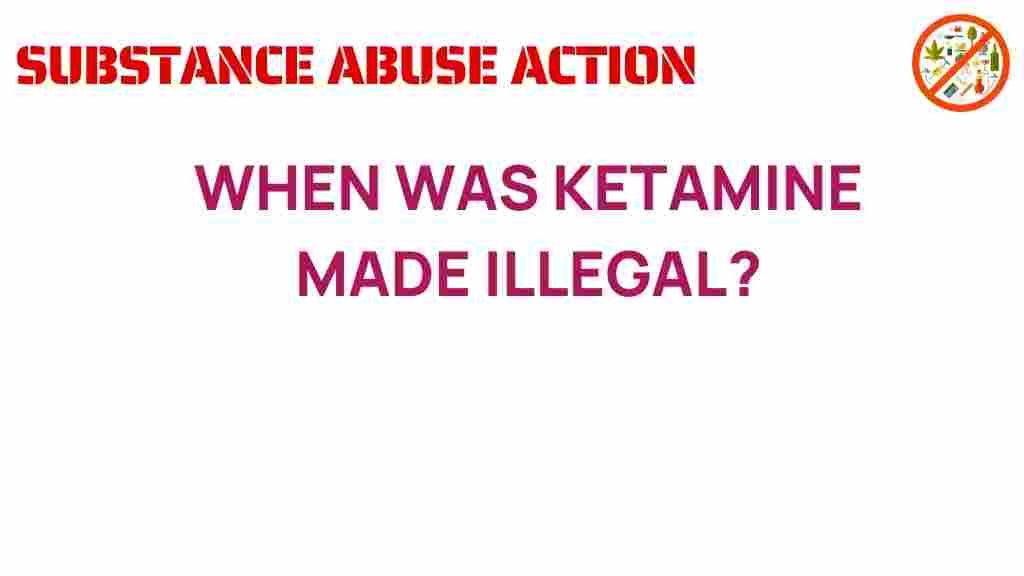Ketamine: The Surprising History of Its Legality
Ketamine, a drug originally developed for use as an anesthetic, has a fascinating and complex history that intertwines with issues of legality, drug policy, and mental health treatment. Understanding when ketamine was made illegal and the surrounding regulations provides insight into its role in modern medicine and the ongoing debates about addiction and mental health.
The Origins of Ketamine
Ketamine was first synthesized in 1962 by Dr. Calvin Stevens, a chemist at Parke-Davis. It was developed as a safer alternative to phencyclidine (PCP), which was known for its unpredictable effects. Ketamine quickly gained popularity in medical settings, particularly during the Vietnam War, where it was used as a battlefield anesthetic due to its rapid onset and safety in compromised patients.
Early Regulations and Controlled Substances
Initially, ketamine was not classified as a controlled substance and was widely used in clinical settings. However, as its recreational use began to rise in the 1970s and 1980s, concerns over its potential for abuse prompted regulatory bodies to take action.
- 1970: The Controlled Substances Act was enacted in the United States, categorizing drugs into schedules based on their potential for abuse and medical utility.
- 1975: Ketamine was placed in Schedule III of the Controlled Substances Act, which allowed for medical use but established regulations to control its distribution and prescription.
This designation meant that while ketamine could still be used for medical purposes, it was subject to stricter regulations, including record-keeping and reporting requirements for healthcare providers.
The Rise of Recreational Use and Addiction Concerns
As the years progressed, ketamine gained notoriety as a recreational drug, particularly in club scenes, where it was often referred to as “Special K.” Its dissociative properties made it popular for its euphoric effects, but this also raised significant concerns regarding addiction and misuse.
By the late 1990s and early 2000s, increased reports of ketamine abuse surfaced, leading to further scrutiny by health officials and policymakers. Misuse of ketamine can lead to:
- Psychological dependence
- Negative impacts on mental health
- Physical health complications
Legislative Actions and Global Perspectives
In response to the growing concerns over ketamine’s recreational use, various countries began to reevaluate its legal status. The approach to ketamine’s legality varied widely around the world:
- United States: Continued classification as a Schedule III substance, with ongoing debates about its medical use.
- United Kingdom: In 2006, ketamine was classified as a Class C drug under the Misuse of Drugs Act, which made it illegal to supply, produce, or possess without a license.
- Australia: Ketamine is classified as a Schedule 4 drug, meaning it can only be prescribed by a medical professional.
The differences in regulations reflect diverse approaches to drug policy, public health, and addiction treatment. While some countries focused on controlling misuse, others explored the therapeutic potential of ketamine, particularly in mental health.
Ketamine in Mental Health Treatment
In recent years, ketamine has garnered attention for its rapid-acting antidepressant properties. Research has shown that ketamine can provide relief for individuals suffering from treatment-resistant depression and other mental health disorders. This has led to a reevaluation of its place in medicine and discussions about how drug policy should adapt to include new scientific findings.
Key points about ketamine in mental health treatment include:
- It is effective in rapidly alleviating symptoms of depression.
- It has demonstrated efficacy in treating PTSD and anxiety disorders.
- Ketamine clinics have emerged, offering specialized treatments under medical supervision.
Future of Ketamine Legality and Drug Policy
The evolving landscape of ketamine as a treatment option raises critical questions about drug policy and the legality of controlled substances. As more research highlights the benefits of ketamine in mental health treatment, stakeholders must consider:
- How to balance regulation with access to effective treatments.
- The importance of education regarding the risks of misuse.
- Integrating ketamine therapy into broader mental health care frameworks.
These discussions are vital for shaping future policies that address both the potential benefits and risks associated with ketamine use.
Troubleshooting Common Misconceptions
Understanding ketamine’s history and legality is essential, but there are several common misconceptions that need to be addressed:
- Misconception 1: Ketamine is purely a party drug. While it is misused recreationally, it has legitimate medical uses, particularly in anesthesia and mental health.
- Misconception 2: All forms of ketamine are illegal. Medical ketamine, prescribed by a licensed professional, is legal and regulated.
- Misconception 3: Ketamine is not effective for mental health. Research supports its use for certain conditions, particularly when other treatments have failed.
Conclusion: Navigating the Future of Ketamine
The history of ketamine is a testament to the complexity of drug legality and policy. As we have seen, ketamine’s journey from an anesthetic to a controlled substance reflects the ongoing struggle between regulation and therapeutic potential.
As research continues to uncover the benefits of ketamine in treating mental health disorders, it is crucial for policymakers, healthcare providers, and the public to engage in informed discussions about its legality and safe use. A balanced approach that prioritizes mental health treatment while minimizing the risks of addiction will be key in navigating the future of ketamine.
For further reading on drug policy and mental health, visit this resource. You can also explore more about the history of controlled substances and their impact on society at this external link.
This article is in the category Treatment and created by SubstanceAbuseAction Team
